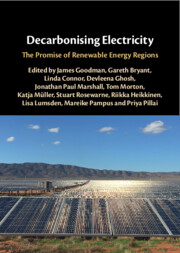2 - Renewable Energy Regions
Cases and Policy
Published online by Cambridge University Press: 20 June 2025
Summary
The chapter tracks the field of renewable energy transition in the three sub-national states where the ethnographic studies are located: Karnataka, Brandenburg, and South Australia. It applies the conceptual model outlined in Chapter 1 to address the full scope of the transition in these regions. The model is used to analytically ‘unbundle’ the dimensions of transition in the three contrasting regions of study, allowing deeper understanding of the relations in play. The chapter focuses on each state in turn, providing historical and contemporary data about renewable energy policy-making and development at the region level in the context of national authorities and global institutions and agencies. We demonstrate the process of renewable ‘capture’ by capital, but also how it is contested and the extent to which it prefigures more democratic social relations and new ‘forms of collective life’.
Information
- Type
- Chapter
- Information
- Decarbonising ElectricityThe Promise of Renewable Energy Regions, pp. 53 - 96Publisher: Cambridge University PressPrint publication year: 2025
References
Accessibility standard: Inaccessible, or known limited accessibility
Why this information is here
This section outlines the accessibility features of this content - including support for screen readers, full keyboard navigation and high-contrast display options. This may not be relevant for you.Accessibility Information
Content Navigation
Allows you to navigate directly to chapters, sections, or non‐text items through a linked table of contents, reducing the need for extensive scrolling.
Provides an interactive index, letting you go straight to where a term or subject appears in the text without manual searching.
Reading Order & Textual Equivalents
You will encounter all content (including footnotes, captions, etc.) in a clear, sequential flow, making it easier to follow with assistive tools like screen readers.
Visual Accessibility
You will still understand key ideas or prompts without relying solely on colour, which is especially helpful if you have colour vision deficiencies.
You benefit from high‐contrast text, which improves legibility if you have low vision or if you are reading in less‐than‐ideal lighting conditions.
Structural and Technical Features
You gain clarity from ARIA (Accessible Rich Internet Applications) roles and attributes, as they help assistive technologies interpret how each part of the content functions.
